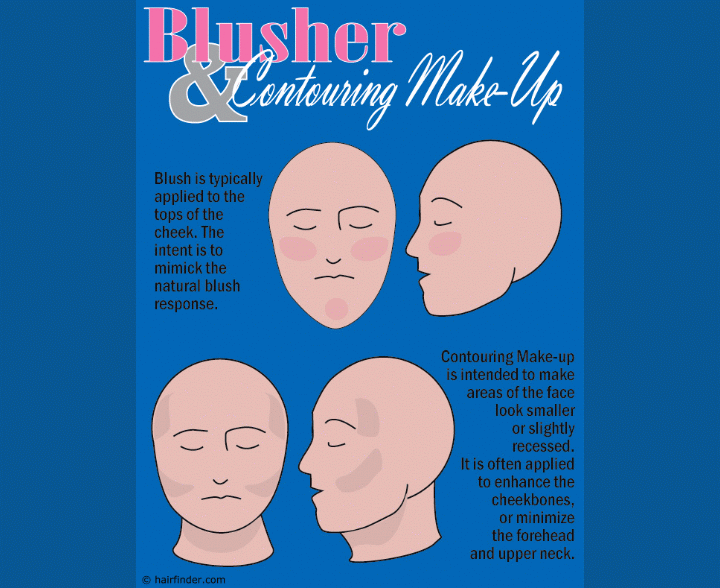Blusher and Contour Application

While any cosmetic product can be prone to misuse if an individual is ill-informed, blusher is often the most obviously misused. You can probably call to memory lots of instances where women you’ve met have appeared overly made-up or clownish because of large swaths of color on their cheeks.
Or sometimes, it’s colorful splashes just below the eyes and other times in curves that touch the corners of the mouth. This is largely due to two factors: the confusion between the purposes of blusher and contouring make-up, and improper color choices for these products.
Differentiating Blusher from Contour
True blusher is intended to help women recreate the light flush of color on the cheeks that occurs naturally in young women. This effect has been desirable for centuries and has its origins in the idea that the blush response is a sign of youth and innocence.
Therefore, a woman whose cheeks were flushed with color would be young – and virginal – and more appealing to the opposite sex. It’s a fairly misogynistic ideal, and has been downplayed over the decades since the emergence of women’s empowerment movements. Today, it is seen typically as just another facet of cosmetics.
Its often-confused counterpart is contour make-up. The primary difference in the appearance of contouring make-up versus blusher is in the color of each. While blusher is colorful – usually pinkish, reddish, or peachy in tone – contouring make-up is neutral-toned and intended to blend in with the foundation base of cosmetic application. A good contouring make-up will be just slightly darker than the foundation base used.
This is because the purpose for contouring make-up is to adapt the appearance of the face’s shape by adding shading and minimizing the appearance of undesired traits. Contouring make-up can be used to minimize double chins, make the jaws appear more defined, give definition to the cheekbones, slim the appearance of the nose, and even minimize the prominence of the forehead.
Using Blusher versus Contour
Most blusher and contour products come as compressed powder and are applied using a brush. This provides excellent control in application and a soft-edged finish. The key to proper usage, however, rests in remembering the purpose for the products.
Let’s start with blusher. Blusher should be applied across the tops of the cheeks, primarily. To apply blusher, simply smile at yourself in a mirror and lightly brush the blusher powder across the “apples” of your cheeks to give them a hint of color. Be careful to keep this color effect subtle, especially in the daytime. You can always go for a heavier application at night (or use a darker shade of color) but in the brighter, broad-spectrum light make-up can be more-easily seen, which isn’t what you want.
The goal is to create a soft “glow” of color, as though you’ve shone a colored light onto the skin. Or, specifically, to create the look you would naturally have if the blood had rushed to your cheeks. In decades past, young women who weren’t allowed to “paint their faces” would often pinch their cheeks or lightly slap themselves to redden their faces a touch and give the blushed impression.
Contouring make-up is different in spite of the fact that it looks so similar to blusher. Contouring make-up is typically available in neutral shades and looks a good deal like pressed-powder foundation. In fact, some pressed-powder foundation (pancake make-up) can be used in place of contour make-up is you are intending to cover larger areas, or if you want to make matching the tone of your cosmetics easier. (You simply purchase your base foundation color and then select a second in a shade or two darker for contouring.)
Apply the contouring make-up in any area you wish to make appear recessed. Because the color is darker than the foundation, the result is that the area will look farther back from the foreground. Typical areas where contouring make-up is used is the area below the chin (the upper neck, sometimes called “the wattle”) where aging and weight can result in looser, or sagging skin, below the cheeks to make the face look slimmer, or along the sides of the forehead to make the forehead appear narrower or the eyes appear broader.
Just remember that you don’t want the effect to appear obvious. As with all cosmetics, proper application means that the individual appears not to be wearing make-up at all. You can use a heavier application at night, but don’t use a lot of make-up and expect a natural look.
©Hairfinder.com
See also: More about how to use make-up